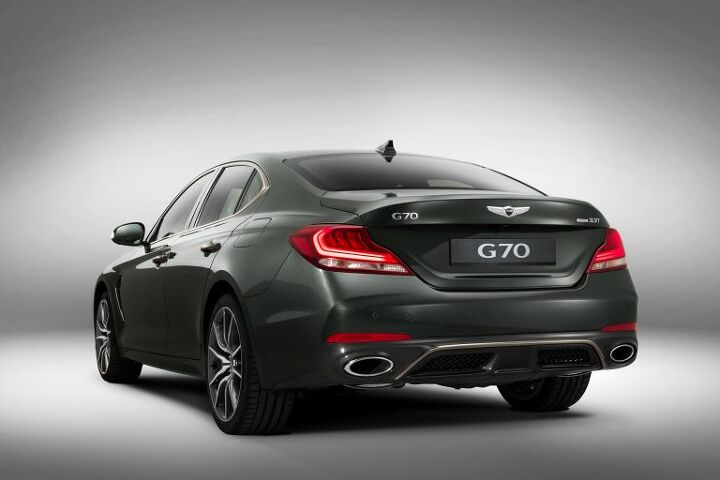Genesis Motors Boss Pays No Attention to the Kia Stinger
The 2018 Kia Stinger and 2018 Genesis G70 are platform partners, two new sporty and luxurious four-doors from the Hyundai Kia Automotive Group.
The timing of their release is synchronized. They utilize the same engine portfolio. They’ll compete in a similar price bracket. But there are differences. For starters, the styling is markedly different, the kind of difference one expects to find when one car, the Kia, is a hatchback and the other is a sedan. The Kia Stinger works harder to get noticed; the Genesis G70 is more subdued.
But while Hyundai’s Genesis spinoff will need to further differentiate the G70 from a marketing standpoint in order to provide a true luxury brand glow, it’s already been made clear by Albert Biermann, the former BMW chassis guru who’s now head of vehicle testing for Hyundai and Kia, that the cars are very similar. In terms of driving experience, “It’s not so easy maybe as with the styling, but I think we can find good tuning and calibration that set them a little bit apart,” Biermann said earlier this year.
A little bit.
Yet in a conversation with Manfred Fitzgerald, the senior vice president at the Genesis brand, Wards Auto received a strikingly different answer. Asked how the Genesis G70 differs from the Kia Stinger, Fitzgerald says, “You tell me. I don’t look at the Stinger. We’re focusing on something totally different.”
Your teenager calls this
Again, the two cars are different, different enough that buyers who favor the Genesis G70 might not even like the look of the Kia Stinger. The Audi A7 has proven that consumers — even American consumers — are willing to overlook a liftback. (The A7 easily outsells the Mercedes-Benz CLS, for example.) But there’s no denying Kia’s market is limited both by a bodystyle Americans have often rejected and, at the Stinger’s lofty price point, the Kia badge. The K900 hasn’t exactly displayed a collective American willingness to spend big on Kias, what with its $50K MSRP and 40 sales per month.
Manfred Fitzgerald, U.S. Genesis boss Erwin Raphael, and the entire Genesis team would have you believe Genesis is different. Premium vehicles that proudly wear Made In Korea on their sleeves will be perceived as high-end luxury. Genesis won’t move any further downmarket than the G70 in order to protect the aspirations of the brand. Genesis is more interested in crafting the right kind of image than selling the right number of vehicles, they’ll say.
But then, in America, you’ll go to buy a Genesis G70 and discover that it’s being sold alongside the Hyundai Accent in the very same showroom, and you’ll wonder just how strong this luxury image really is. 350 of Hyundai’s 800 dealers sell Genesis’ sedans. Raphael wants that number to shrink; he also wants to speed up the process of building standalone Genesis stores.
Until then, however, what’s the big difference between the Genesis G70 and Kia Stinger? Wards doubled down and asked Manfred Fitzgerald a second time, citing the shared platform and engine lineup. “That’s a stretch,” Fitzgerald says. “Other cars share the same platform, and you wouldn’t be asking that question. As a corporation, it is normal and makes economic sense to share platforms and components.”
Indeed, vehicles as distinct as the Audi A5 and Bentley Bentayga ride on variations of the same platform. But Hyundai and Kia, to be fair, are not Audi and Bentley. “It’s all about how you bring across to the customer that they don’t feel they are driving or seeing the same car,” Fitzgerald says.
And he’s right. So now, in America, Genesis must bring across to the G70 customer that the Genesis buying experience is superior to the Kia Stinger buying experience.
[Images: Hyundai, Kia Motors]
Timothy Cain is a contributing analyst at The Truth About Cars and Autofocus.ca and the founder and former editor of GoodCarBadCar.net. Follow on Twitter @timcaincars and Instagram.
More by Timothy Cain
Latest Car Reviews
Read moreLatest Product Reviews
Read moreRecent Comments
- 3-On-The-Tree My 2009 C6 corvette in black looks great when it’s all washed and waxed but after driving down my 1.3 mile long dirt road it’s a dust magnet. I like white because dust doesn’t how up easily. Both my current 2021 Tundra and previous 2014 Ford F-150 3.5L Ecobomb are white
- Bd2 Would be sweet on a Telluride.
- Luke42 When will they release a Gladiator 4xe?I don’t care what color it is, but I do care about being able to plug it in.
- Bd2 As I have posited here numerous times; the Hyundai Pony Coupe of 1974 was the most influential sports and, later on, supercar template. This Toyota is a prime example of Hyundai's primal influence upon the design industry. Just look at the years, 1976 > 1974, so the numbers bear Hyundai out and this Toyota is the copy.
- MaintenanceCosts Two of my four cars currently have tires that have remaining tread life but 2017 date codes. Time for a tire-stravaganza pretty soon.




































Comments
Join the conversation
The Kia's design language and frippery scream: it coulda' had a V8. It oughtta be law: four exhaust tips shall be permissible only with a minimum of eight cylinders.
In the end, they are still Kia/Hyundai and have a lower than luxury brand reputation. Not to mention the lousy, and many times disrespectful factory representatives that are overly concerned with saving the company money than fixing the warrantable items on their cars.